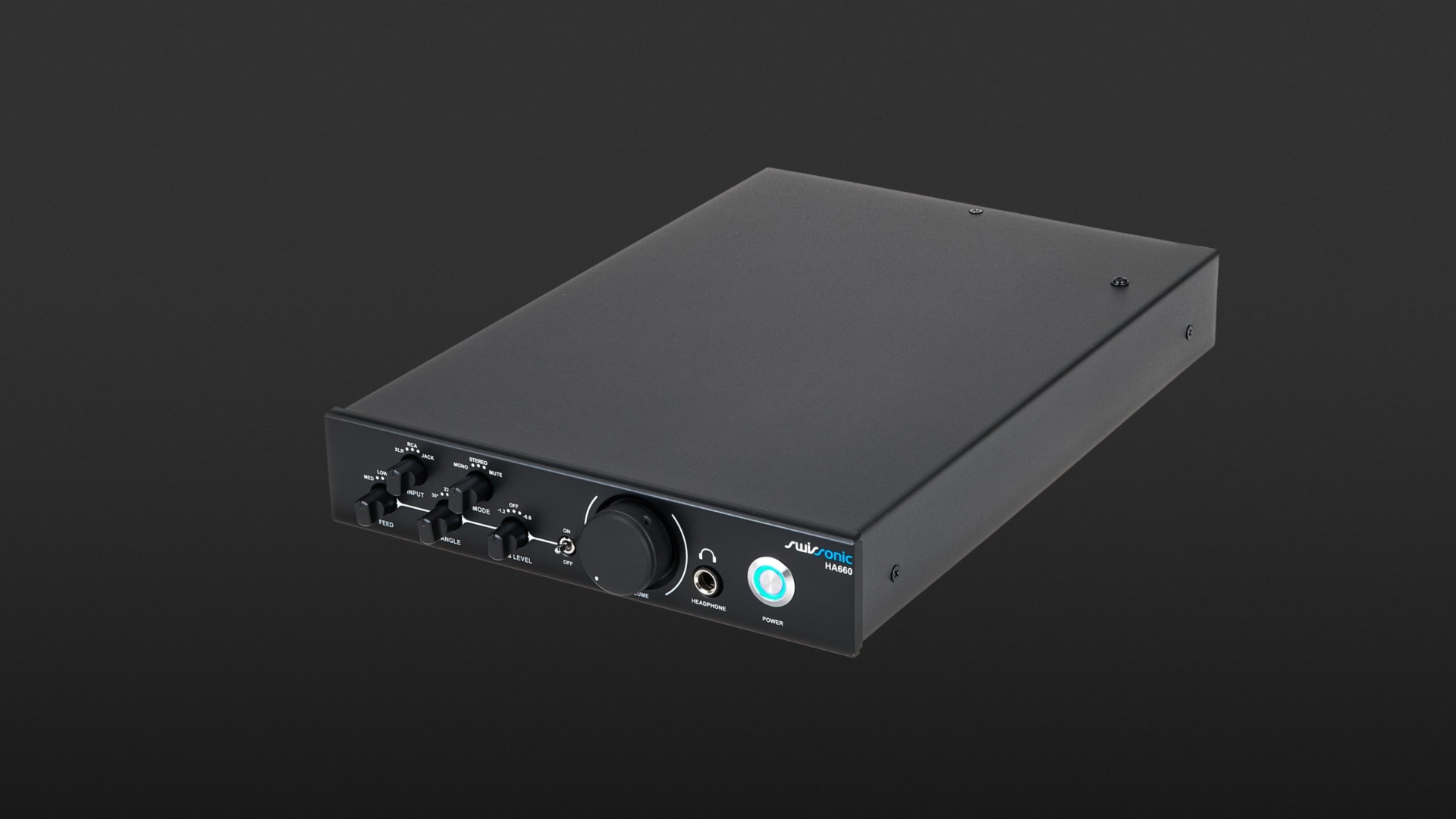Extensive power reserves for driving a wide range of headphone models, a successful variety of connections for different applications and a flexibly adjustable crossfeed function are the highlights of the Swissonic HA660. But in terms of sound, this headphone amplifier has nothing to hide. It delivers a balanced sound image with a slightly warm colouration and amazing bass.
In the 200 euro price range, the Swissonic HA660 is unrivalled with this range of functions and sound. Therefore, I can only give it a recommendation.
- Sturdy aluminium housing
- Suitable for magnetostatic headphones
- Balanced sound
- Adjustable crossfeed function
- Connection panel for three stereo inputs (two of them balanced)
Lavish power reserves for driving a wide variety of headphone models, a wide range of connections for different uses and a flexibly adjustable crossfeed function – these are the affordable Swissonic HA660’s highlights.
With its own brand “Swissonic”, music store Thomann offers affordable products for the studio sector. These include monitoring monitors, audio interfaces and headphone amplifiers. In the meantime, the latter product category has grown to four models, and the Swissonic HA660 Headphone Amp tested here is the largest model of the series, priced at just under 200 euros, with features that will be familiar from far more expensive competitor products.
Design, operation and connections
The all-black, sturdy aluminium housing features all control and switching units on a solid front panel. The input sources “XLR”, “RCA” or “JACK” can be selected via potentiometer. A control for the playback mode in stereo, mono or mute is located directly next to it. Below that, there are controls for the parameters “Feed” and “Angle”. These can be used to adjust the crosstalk of the left channel to the right channel and vice versa, as well as to determine the virtual positioning of speakers. In addition, the “M/S Level” controls the mid-side level ratio and the complete crossfeed section can be activated or deactivated. Both the control names and the adjustable values are reminiscent of the crossfeed matrix system familiar from SPL. But more on that later.
The large and easy-to-grip volume control is pleasantly heavy, right next to it is the headphone output, which is a 6.35 mm jack, and the main unit switch.
The rear panel offers three stereo input connectors. These include symmetrical versions in XLR and TRS and the asymmetrical connection RCA (Cinch). In addition, the selector switch for the power supply and the mains plug with fuse can be found here.
Overall, the unit makes a good impression with its pleasantly smooth controls, sturdy housing and XLR sockets screwed onto the back.
Sound
A wireless MTX monitor with an integrated headphone amplifier served as our playback device allowing direct comparisons. Other playback devices we used were a Cambridge Audio CXN V2, a CD player (NAD 512), a smartphone (Samsung Galaxy S7) and an iBasso DX 240 Reference DAP . The headphones we used were models from Stax, Hifiman Edition XS, Focal Spirit Pro, Sony MDR-V600 and the Sennheiser HD 25 II.
First and foremost, we checked whether the stereo imaging changed as soon as the volume potentiometer was slowly turned up, starting from the lowest setting. Unfortunately, there was a left-right offset of the panorama in the lowest volume range. However everything was fine with the volume potentiometer’s control path: Here, a constant increase of the volume was observed without level jumps. In addition, headphones with different impedances were connected to determine whether the unit provided sufficient power even for high-impedance devices. The HA660 provided sufficient amplification so that all headphone models could be operated even at ear-splitting volume. This made the unit suitable not only for the sound control room but also in the recording room for a drummer playing to a backing track with headphones. The Swissonic HA660 offers a noise-free, solid basic sound even at the lowest volume. The dynamic gradations were reproduced with fine resolution. The representation of individual instruments was differentiated in the stereo field and corresponding associated reverb tails were clearly assigned to the instrument. Even dense sound passages remained transparent and well resolved. And the HA660 was equally convincing in terms of depth. Due to the power reserves, the unit was also suitable for processing very quiet sound passages, as these were reproduced noise-free at high amplification. Even the power-hungry Hifiman Edition XS with its 18 ohms still had enough reserves at high volumes.
The Swissonic HA660 delivered warm and punchy lows. From my playlist, I listened to “Boris Blank & Malia – Celestial Echo (Convergence)” with powerful bass and a lot of pressure. It’s amazing what a difference an additional device that “only” takes care of amplifying headphones makes. The Hifiman Edition XS, which is otherwise a bit difficult to drive, was well-fed here and received the necessary power equipment to fulfil its task.
The HA660 behaved just as well in the midrange frequencies. Malia’s vocals sounded articulate and rich in detail. Especially in the midrange, where the main part of all instruments is concentrated, this differentiated resolution was desirable, and it was realised here.
The treble range was also worth listening to. High-frequency percussive elements ignited the necessary sparkle and delivered a pearly clarity that let the sonic firmament shine. The Swissonic HA660 makes it clear that it is not a beginner, and it knows how to get the job done.
Crossfeed
The circuit used here is not explicitly called a crossfeed function by the manufacturer. The idea behind this function: Part of the right channel is mixed into the left side and part of the left channel into the right side to represent a speaker simulation on headphones. The otherwise missing centre in the stereo field is artificially created, and there is an attempt to cancel the strong separation of the two channels. The result is a more natural listening experience like one would be used to from loudspeakers.
After listening with this function for a while, the settings that initially seemed less audible become clearer and more detectable. The perception of the panorama changed. Musical elements that are otherwise very far apart moved closer together were less separated and formed a more homogeneous sound image. This created a sound impression more like the one that we were used to from listening with loudspeakers. The phantom centre was more present, and the sound built up around it. If you switch off the crossfeed function while listening, the homogeneous sound breaks up, and you have the impression that the musical elements stand alone in the room. Once you get used to this special sound image, you won’t want to do without it.
Technical specifications
- Ear couplingAmplifier
- TypeDesktop
- Frequency response (headphones)20 - 20.000 Hz
- Impedance3,3 ohms
What's in the box
Special features
- Input impedance: XLR 20 kΩ (balanced), 10 kΩ (unbalanced); RCA 10 kΩ; TRS 20 kΩ, (balanced), 10 kΩ (unbalanced)
- Max. input level: XLR +23.5 dBu; RCA +20 dBu; TRS +23.5 dBu
- Output impedance: 3.3 Ω
- Attenuation factor: 180 @ 40 Ω
- Distortion: 0.001
- Signal-to-noise ratio: >95 dB
- Power consumption: max. 15 W
- Dimensions (W × H × D): 217 mm × 41 mm × 318 mm
- Weight: 2.8 kg










































